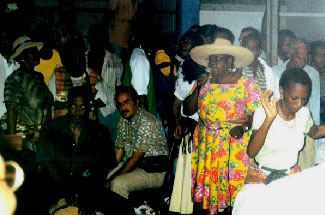 The Creole word Malfanm usually defines a powerful and successful woman. If we look closely at the word, we can note the prefix mal, which could be translated by male and the root fanm, which means woman. It is therefore possible to say that a malfanm or a “malewoman” is someone who has managed to succeed in a male dominated arena, and this is exactly what Mrs.Siméline Rangon has done.
The Creole word Malfanm usually defines a powerful and successful woman. If we look closely at the word, we can note the prefix mal, which could be translated by male and the root fanm, which means woman. It is therefore possible to say that a malfanm or a “malewoman” is someone who has managed to succeed in a male dominated arena, and this is exactly what Mrs.Siméline Rangon has done.
Musically speaking, Gwoka and Bèlè are largely male dominated genres. Traditionally, in la rond Bèlè (the circle in which Bèlè is danced and played) men are lead singers and tambouyés (drummers), while women are dancers or part of the repondè (chorus). If one has heard the names of Esnard Boisdur, Ti Emile, Vélo and Galfétè, few are the female names that have impacted the sound of Bèlè and Gwoka. However, even if they are few, these women do exist and for the International Women Month, Zil’oka has endeavoured to run a series of articles to celebrate these women, who have contributed to shape, sustain and pass on our cultural heritage. Controversial, witty and strong, meet our fellow women, our mothers, our sisters, our masters, our pillars of tradition.
Today, we will take you to Martinique where the voice of the late Siméline Rangon still lingers in the swaré Bèlè. Siméline Rangon, is the only woman to carry the title Master of Bèlè. Witty and creative, her songs are social commentaries, filled with double entendre, from which one could retrace, major historical events as well as local gossip. Along with her compositions, Siméline truly mastered the traditional repertoire and passed it on to us with a style unique to her.
Mrs Siméline Rangon was born in 1925 in Reculée, a very green neighbourhood of Ste Marie, Martinique. In spite of the fact that Bèlè and its practitioners had a very bad reputation at the time, (do check out our article on Bèlè here) Siméline’s family did not object to her heavy involvement in la rond bèlè. Indeed, although Siméline was a remarkable dancer, health problems prevented her from performing the physically demanding steps of Bèlè dance. Yet, Siméline did not give up and from age 12, she made her début in Bèlè solo singing.
As it was said earlier, women are not expected to be lead singers, and even nowadays, men still greatly outnumber women in this role. The functions in La rond Bèlè are still very much fixed by gender and some people, in this century, are still very much horrified to see women drummers. Therefore for a teenager circa 1930’s to have had the opportunity and the audacity to enter this circle as a lead singer-especially at a time where Bèlè was not regarded as a valuable aspect of the Martiniquan culture-is truly baffling. This says something about her character and the ever changing and accommodating nature of Bèlè.
If we know that she has succeeded in this path that she had chosen, her journey as a women lead singer and the challenges that she may have faced are unknown to us. We can call for the elders to revive their memory and tell us her story, but for now we will remain silent about her life and listen to her voice. What is certain and what we celebrate today is that Mrs. Siméline Rangon was a Malfan, a recognised singer, respected by both men and women. Her musical genius was recognised at home and abroad while academics compared her to an aoidos, the oral epic poets of ancient Greece. She has paved the way for the women singers of today and kept our tradition alive in her own unique way and against all odds.
A friend, a wife, a sister and a Master of Bèlè, Mrs. Rangon has joined the ancestors on November 3rd 2008, but her legacy lives on. Man Sim, Zil’oka is very proud to open this series with you. Lonè èk rèspé.
by Nathalie Montlouis
